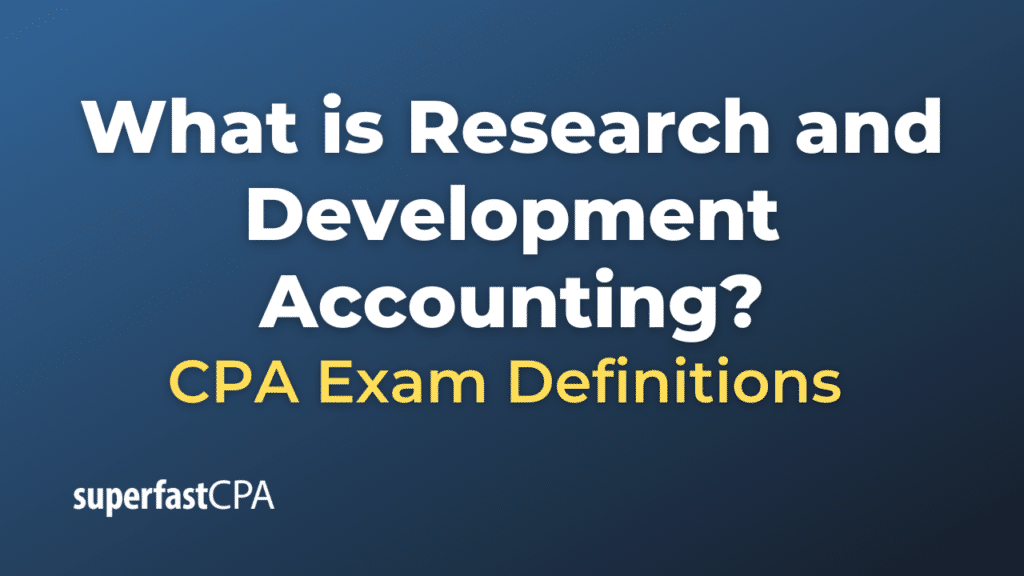Research and Development Accounting
Research and Development (R&D) Accounting refers to the methods and practices used to account for and report the costs associated with the R&D activities of an entity. Given the significance of R&D for many businesses, especially in industries like pharmaceuticals, technology, and automotive, it’s crucial to understand how these costs are recognized and treated in financial statements.
Key Aspects of R&D Accounting:
- Expense vs. Capitalize:
- Generally, under both U.S. Generally Accepted Accounting Principles (U.S. GAAP) and International Financial Reporting Standards (IFRS), R&D costs are expensed as incurred. This means they’re recognized in the income statement immediately, reducing the entity’s net income for the period.
- However, under IFRS, once the project has met certain criteria that demonstrate the asset will probably generate future economic benefits, the subsequent R&D costs can be capitalized (i.e., recognized as an asset on the balance sheet) and then amortized over its useful life.
- Disclosure:
- Entities typically disclose their accounting policies for R&D and the amounts expended during a period in the notes to their financial statements.
- Tax Implications:
- Some jurisdictions offer tax credits or deductions for R&D spending to promote innovation. This means that while the costs might be expensed for financial reporting purposes, they could provide tax benefits.
- Impairment:
- If R&D costs are capitalized (like under IFRS, given certain criteria are met), these capitalized amounts should be checked regularly for impairment. If the value of the R&D project decreases (e.g., the project is no longer expected to be viable or profitable), the capitalized amount might need to be written down.
Example of Research and Development Accounting
Let’s delve into a more detailed example to understand the intricacies of Research and Development (R&D) accounting:
InnovateTech, a fictional tech company, is working on the development of an advanced wearable health monitoring device. During the fiscal year 2023, the company incurs the following costs:
- Research Costs:
- Preliminary research to understand the market demand and potential technologies: $2 million
- Studies to identify potential health metrics the device can monitor: $1 million
- Development Costs:
- Design and prototype of the wearable device: $5 million
- Testing of the prototype: $2 million
- Patent filing and legal fees related to the device: $0.5 million
For our example, we’ll consider the accounting treatment under both U.S. GAAP and IFRS:
U.S. GAAP:
Under U.S. GAAP, all R&D costs are expensed as incurred.
- Total R&D Expense for 2023: $2 million + $1 million + $5 million + $2 million = $10 million
- The patent filing and legal fees ($0.5 million) related to the device would also typically be expensed.
- Thus, InnovateTech’s income statement for the year 2023 will show an R&D expense of $10.5 million, reducing the company’s net income by this amount.
IFRS:
Under IFRS, research costs are expensed, but development costs can be capitalized once certain criteria (like demonstrating the product’s viability and the intention to complete and sell the product) are met.
- Total Research Expense for 2023: $2 million + $1 million = $3 million (This is expensed in the income statement)
Assuming InnovateTech can demonstrate the device’s viability and their intention to complete its development:
- Development Costs to be capitalized as an intangible asset: $5 million + $2 million = $7 million
The $0.5 million for patent filing and legal fees would also be capitalized as it adds to the value of the intangible asset.
- Thus, InnovateTech’s balance sheet at the end of 2023 would show an intangible asset of $7.5 million. This asset will be amortized over its useful life in the subsequent years.
This example demonstrates how R&D costs can have a different impact on financial statements based on the accounting standards in use. Under U.S. GAAP, the entire R&D outlay impacts the company’s profit and loss in the year the costs are incurred. Under IFRS, a portion of the costs (related to development) can be deferred to future periods through capitalization and subsequent amortization.












